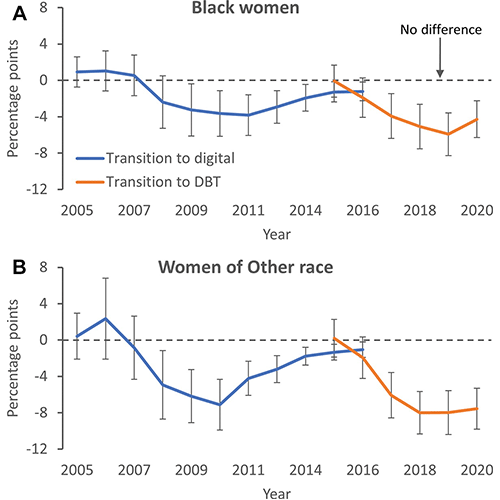Racial Disparities in Access to Newest Mammography Technology
New study suggests policy changes to public payer reimbursements



Breast cancer, the most common cancer among women, demonstrates high survivability rates with early detection and treatment. Earlier detection has been facilitated by major technological advances, in particularly the evolution from screen-film mammography (SFM) toward full-field digital mammography (FFDM) and digital breast tomosynthesis (DBT).
DBT has now been demonstrated to lower recall rates and improve cancer detection compared with FFDM.
Despite these life-saving advances, the difference in breast cancer mortality between Black and white women in the U.S. is 40%, even though the cancer incidence rate between these groups is equal.
New research published in Radiology suggests that this concerning difference in mortality rates may be in part due to racial disparities in access to the latest mammography technology, driven by economic factors. The article proposes changes to reimbursement policies of public payers.
A Question of Access
The study examined the connection between race and use of newer mammographic technology in women receiving these services. The researchers used a 5% sample of Medicare fee-for-service insurance claims data from 2005 to 2020.
“In order to look at the transitions, from film to digital mammography, and then from digital to three dimensional, we needed the study to cover a long period to see what was happening with access to the newer technology over time,” said first author Eric Christensen, PhD, director of economic and health services research for the Harvey L. Neiman Health Policy Institute, and adjunct professor of health services management at the University of Minnesota in Minneapolis.
The research team looked both within individual institutions, and across comparable institutions, to determine differences in mammographic technology use according to patient race. In multivariable regression models, they adjusted for multiple patient-level factors that could impact use, including age, urbanicity, per capita income and Charlson comorbidity score, which predicts the ten-year mortality for a patient who may have a range of comorbid conditions.
After analyzing a sample of more than four million mammography claims during the study period, the researchers found that Black women were 20% less likely than white women to receive digital mammography after its implementation in 2005, and 16% less likely than white women to receive DBT after its implementation in 2015.

Graphs show percentage-point differences according to race for receiving mammography at an institution with equal capability for newer mammographic imaging (comparable institution differences) from 2005 to 2020 for (A) Black compared with white women and (B) women of other race compared with white women. For the transition to digital mammography, there was a pattern of deepening racial differences as the transition progressed followed by decreasing racial differences as digital became universal. For the transition to digital breast tomosynthesis (DBT), there was a similar pattern of deepening racial differences and the beginning of decreasing differences as DBT has become more prevalent. For the transition to the digital model (2005–2016), newer technology was defined as full-field digital mammography or DBT. For the transition to the DBT model (2015–2020), newer technology was defined as DBT only. Other race includes Asian, Hispanic, North American Native, and other. Error bars represent 95% CIs.
https://doi.org/10.1148/radiol.221153 ©RSNA 2022
Policies to Support Equitable Diffusion of New Technology
Third author Jinel Scott, MD, MBA, points out that these access disparities among patients with the same insurance coverage in the same institutions is disturbing, but that overt discrimination is likely not to blame.
“The most striking finding is the fact that among women with the same insurance, who went to the same institution, Black women were less likely to receive the newer imaging technology. However, I don't necessarily think it's a situation where Black patients are sent to one machine and white patients to another,” said Dr. Scott, who is associate professor of clinical radiology and chief quality officer at New York Health and Hospitals Kings County. She is also a member of the RSNA Board of Directors and is the Board liaison to the RSNA Health Equity Committee.
Current incentives may drive the differences observed that result in racial disparities not because systems intentionally discriminate but because the economic incentives associated with private-public payer mix and Medicare reimbursement policy influence how technology diffuses, according to Dr. Christensen. Locations where the payer mix is mostly private are more likely to receive newer technology sooner than locations with a higher proportion of public payers.
“Because reimbursement is a lot less in a government payer population, when institutions ask themselves where to put new technology first, they're going to put it where it can get the biggest return,” he said. “We may not like that choice, but it's an economically logical choice.”
The authors say that advocacy for favorable reimbursement and incentive policies, such as grants for imaging centers serving a high proportion of public payers, may help to diminish these differences.
The research also suggested a time-sensitive need for policies to reduce disparities as new technologies are being implemented, because the racial differences in access to new imaging technology were transitory and subsided as the new technology became universal.
“Our study demonstrates that transitional disparities associated with technological advances in breast imaging exist, and that private-public payer mix influences how technology diffuses,” said co-author Bhavika K. Patel, MD, associate professor of diagnostic radiology and vice chair of research for radiology in the Department of Radiology at Mayo Clinic Arizona. “Financial incentives that facilitate a more equitable transition of technology will help institutions that serve disadvantaged populations offer newer screening technologies quicker.”
“Radiology sits at the intersection of so many issues, yet sometimes we don’t understand just how extensive our reach is. We are perfectly positioned for advocacy and education in this space. That higher mortality rate of 40% is not just a number. It represents people who are worth fighting for. In order to do that, we need to come out of the dark.”
—JINEL SCOTT, MD, MBA
Time to 'Come Out of the Dark'
The authors of an accompanying commentary about this research recognize the value of limiting the study analysis to patients with Medicare coverage, which allowed the examination of racial differences in access without the confounder of insurance status.
The editorial does caution, however, against drawing conclusions about health outcomes due to inequitable access to screening technology.
“Although this study examines use of newer technologies based on race, differences in use should be tied to differences in outcomes to truly demonstrate health inequities,” wrote the editorial authors. As far as radiology’s role in this and other health disparities, Dr. Scott says that it’s time for radiologists to get comfortable outside the reading room.
“Radiology sits at the intersection of so many issues, yet sometimes we don’t understand just how extensive our reach is. We are perfectly positioned for advocacy and education in this space,” she said. “That higher mortality rate of 40% is not just a number. It represents people who are worth fighting for. In order to do that, we need to come out of the dark.”
For More Information
Access the Radiology study, “The Relationship between Race and Access to Newer Mammographic Technology in Women with Medicare Insurance,” and the accompanying commentary.
Read previous RSNA News stories about mammography:
- Access, Cost and Awareness Among the Barriers to Screening Mammography
- AI Shows Potential in Breast Cancer Screening Programs